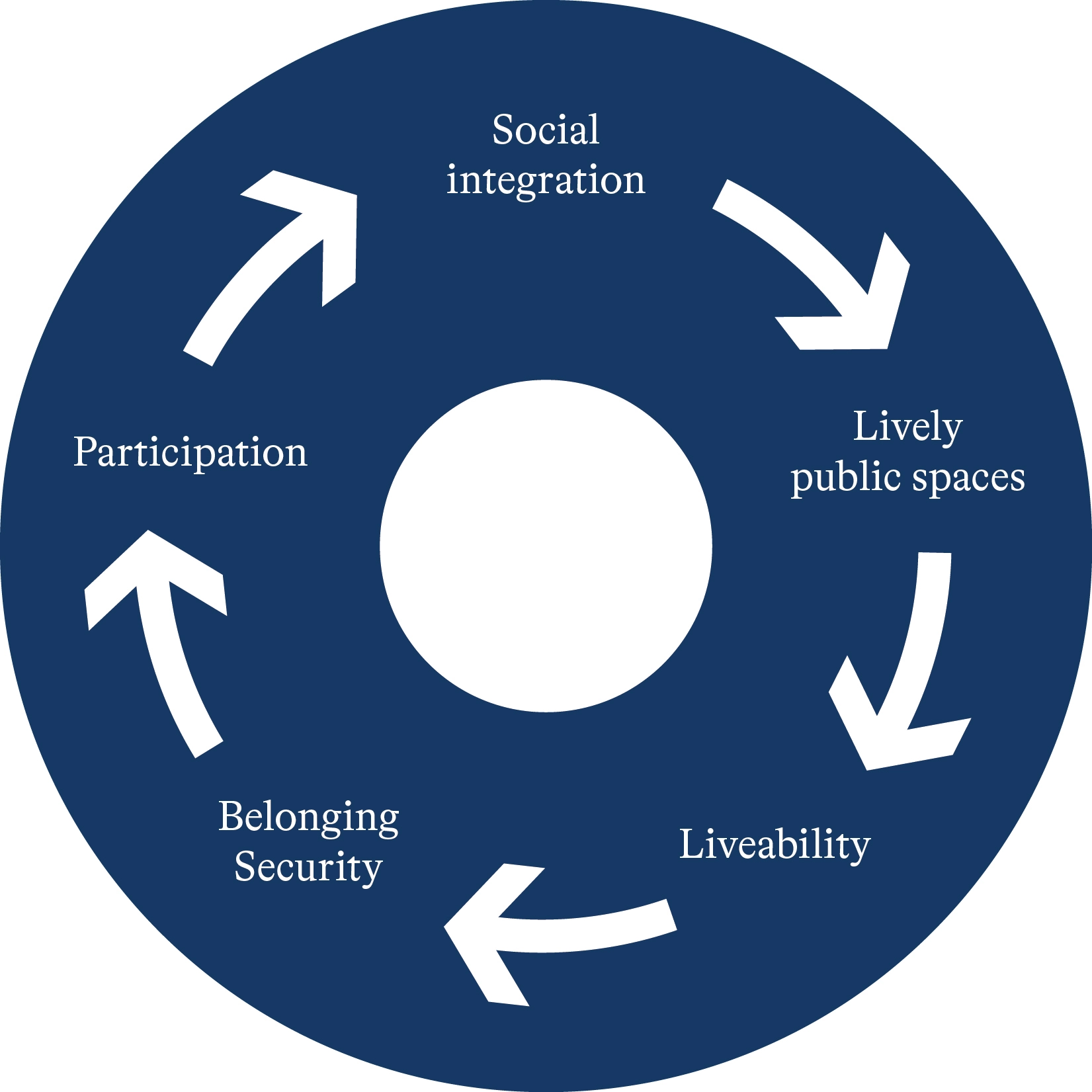The social integration of people is closely linked to public space. Cities have always been and continue to be living spaces for people, social melting pots and densely populated areas where people live together.
However, it is not immediately obvious how this social goal relates to public space. BURRI's Public Space Cycle visualizes this connection.
The Public Space Cycle shows that social integration in public spaces can only arise through the presence of mutually dependent and positively influencing factors.
Public spaces are more important than buildings. They make a city alive.
Amanda Burden, ehem. Stadtplanerin von New York
How does public participation in public life come about?
The social integration of people in a city is demonstrated by the high degree of participation of the population in public life. It is essential for well-functioning public spaces that the population takes an active interest in them and gets involved in their design and use. However, it also means that people must feel jointly responsible for public spaces, and that they are committed to them and take care of them.
Only when people talk about "their" neighborhood, "their" square or even "their" bench and really feel that way will they become active and enliven the public space while at the same time taking care of it. If a sufficiently large number of people follow these examples, participatory actions emerge that turn pure identification into sustainable participation. This could be, for example, a self-managed urban gardening facility in a street on the initiative of local residents or the communal use of wasteland in a city. But also actions such as cleaning days or the "neighborhood regulars' table" at a nice picnic table on the playground in the neighborhood.
For people to be able to talk about "their" things, "their" public elements in this context, they must be available to them in sufficient numbers, well maintained and invitingly designed. Only through reliability and unrestricted, regular availability.

What does this have to do with security?
The desired participation is perceived differently by each person. However, it only arises where people feel "safe". If, as is generally the case in Switzerland, the population can make public spaces their own more or less unconditionally, this automatically raises concerns about safety.
This is because the desired participation described above also means that the population uses the spaces as they see fit and perhaps not always according to the purpose "intended" for them by planners and owners. It is obvious that conflicts of use arise in this way. Conflicts of use in public spaces are ultimately nothing more than a difference of opinion about how/when/how long/how often/how intensively individual sections of the population participate in public life and claim public spaces and facilities for themselves.
It is a logical consequence that politicians, administrators and society have to weigh up certain interests. How much we as a society should invest in "security" and how "secure" is "secure" will probably be a matter of debate for some time to come. One basic condition remains: A certain degree of "safety" is always necessary for participation in public life and the required and desired social integration.
Primarily, public spaces must be designed and arranged in a way that people perceive their presence in them as 'safe.' Only then will they associate it with "quality of life"
What role does quality of life play?
All people feel differently when asked what "quality of life" means to them. Well-being is always subjective. A public space is a source of high quality of life if it makes people happy to spend time in it and develop their potential.
A high quality of life in a city and public spending on its public spaces correlate with each other. It is not surprising that cities that attach great importance to good public spaces are often at the top of the annual city rankings. Cities that attach great importance to high quality, cleanliness and perceived safety in public spaces. Cities that plan, build, furnish and maintain these spaces with care and prudence.
Public spaces are the calling card of every city and therefore always a means of location marketing.
Good public spaces are true sources of high quality of life. They are always a product of their surroundings, a consequence of their use and depend on what the people in a city make of them and how much value they attach to them.
What are good public spaces? What makes good public spaces?
A good public space therefore ensures the social integration of as many people as possible who use it. To achieve this, it must be planned and designed in such a way that it invites as many people as possible to participate in public life thanks to a high quality of life and perceptible safety. Sounds logical, is logical, but is it realistic?
Of course – if you understand that public space always works when as many needs as possible can be combined as well as possible. However, at first glance, the needs of different stakeholder groups do not appear to be easy to reconcile.